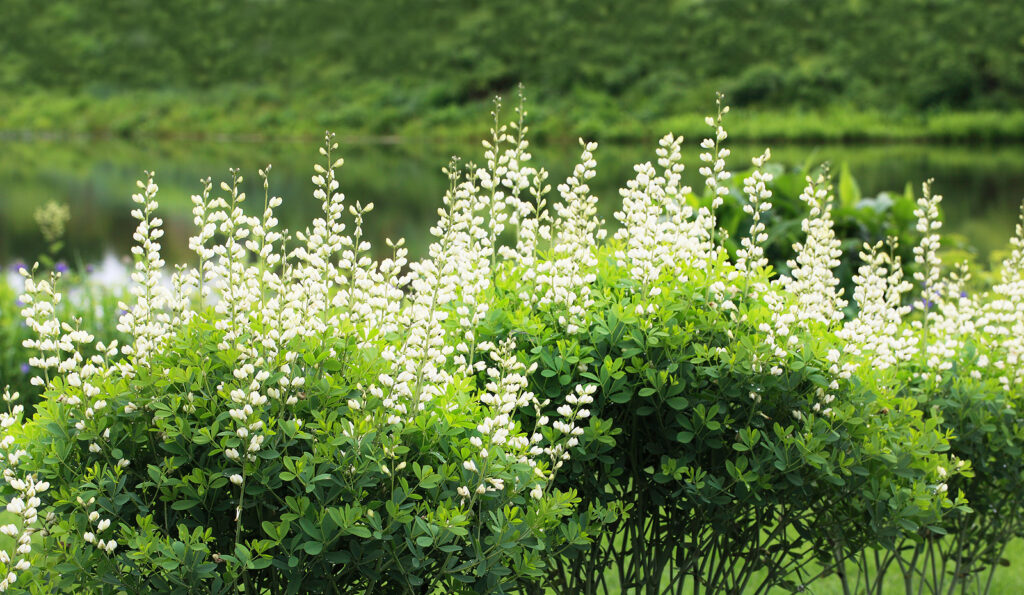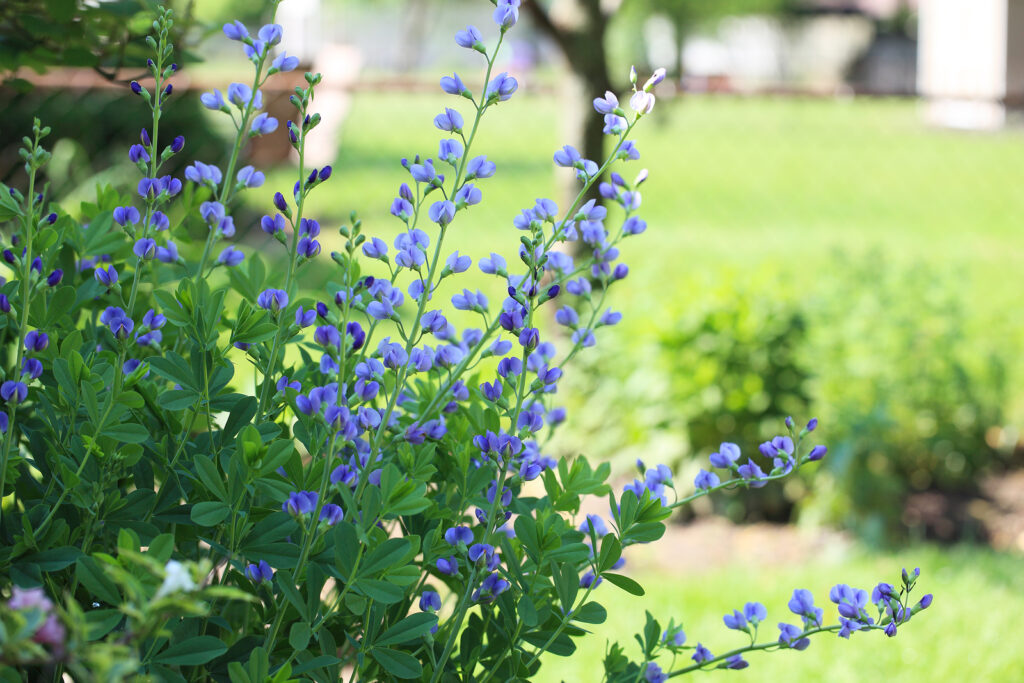Baptisia–commonly called blue false indigo–is a shrubby perennial with indigo-blue flower spikes. In winter, blue false indigo has showy blue-black seedpods on grassy stems. False indigo is attractive in all seasons.
Baptisia is a native of the United States growing wild from Pennsylvania to Texas.
With deep green cut foliage and indigo-blue, white or yellow flowers resembling lupines in form and produced in long terminal racemes, Baptisia often reaches the height of 6 feet, It is an imposing member of the border or wild garden.
Baptisia flowers are good for cutting and the period of bloom is from late spring to midsummer. Blooms are followed by short, plump pods that become black.
Baptisia is easily grown from seed in any good garden soil. It prefers partial shade.

Get to know Baptisia
- Plant type: Perennial
- Growing Zones and range: Zones 3-9; drought and cold-tolerant
- Hardiness: Hardy to about -35°F (-37°C); grown as an annual in cold-winter climates
- Height and width: 2 to 4 feet (60-120cm) tall; 3 to 4 feet (90-120cm) wide
- Form: Mature plants form dense, rounded mounds of three-lobed blue-green leaves
- Flower form: Showy 1-inch flowers are carried on narrow, open spikes; dried gray pods are showy in fall and winter
- Flower color: Blue
- Bloom time: Late spring and early summer
- Uses: Set to the rear of mixed borders or use as a screen; looks good in wildflower meadows
- Garden companions: Plant at the rear of borders; plant with Siberian iris and peonies; plant with ornamental grasses
- Common name: Blue false indigo
- Botanical name: Baptisia australis
- Family: Fabaceae
- Origin: North America
Where to plant Baptisia
- Grow Baptisia in full sun in Zones 3-6 and Pacific Northwest. Plant Baptisia in light shade n Zones 7-9.
- Baptisia prefers rich, well-drained soil but tolerates many soils.
Baptisia uses and companions
- Grow Baptisia in an informal border, wild garden, or on a dry, sunny bank.
- Use Baptisia as a vertical contrast with peony, iris, and shasta daisy in an early summer border.
- Use seedpods in dried arrangements; cut in midsummer when brown.
- Good Baptisia companions include Artemesia, Coreopsis, Oenothera, Sedum, Senecio.

When to plant Baptisia
- Set plants out in spring or fall.
- Baptisia has a long taproot and does not transplant well.
Planting and spacing Baptisia
- Space Baptisia 3 to 4 feet (90-120cm) apart.
How to water and feed Baptisia
- Baptisia needs moderate moisture; keep the soil moist. That said, Baptisia can tolerate dry weather.
- Feed Baptisia with aged compost spread around the plant two or three times a year
Baptisia care
- Mulch around Baptisia to conserve soil moisture.
- Baptisia grows slowly until the taproot is established.
- Stake Baptisia if it becomes top-heavy or floppy.
- Baptisia has no serious pests or diseases.
Baptisia propagation
- Sow seeds in containers in a cold frame in spring.
- Seeds germinate in 7 to 14 days at 75°F (24°C).
- Take cuttings after flowering or sow freed seed in the garden in the fall.
- Divide clumps in fall, late, winter, or early spring using a sharp knife. Mature plants have massive, tough roots that do not like being disturbed.

Baptisia varieties to grow
- Baptisia alba, white wild indigo: Grows 2 to 3 feet (.6-.9m) tall; racemes of white flowers in early summer; cultivar ‘Prairie Smoke’ has pale lilac flowers.
- B. australis, blue false indigo; grows 3 to 5 feet (.9-1.5m) tall with blue-green leaves; clusters of dark blue flowers in early summer followed by spikes of blue-black seedpods.
- B. bracteata, plains blue indigo: grows two 42 inches (106cm) tall with blue-gray leaves and racemes of white flowers in late spring.
- B. pendula: Grows to 42 inches tall; erect racemes of white flowers in early summer.
- B. perfoliata, Georgia wild indigo: Low growing to 24 inches (61cm) tall, spreads to 4 feet; bears solitary yellow flowers in leaf axils in early summer.















